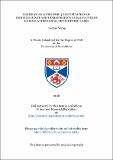Files in this item
Bayesian analysis for quantification of individual rat and human behavioural patterns during attentional set-shifting tasks
Item metadata
| dc.contributor.advisor | Bowman, Eric MacDonald | |
| dc.contributor.author | Wang, Jiachao | |
| dc.coverage.spatial | v, 161 p. | en_US |
| dc.date.accessioned | 2018-07-03T12:39:59Z | |
| dc.date.available | 2018-07-03T12:39:59Z | |
| dc.date.issued | 2018-06-29 | |
| dc.identifier.uri | https://hdl.handle.net/10023/14843 | |
| dc.description.abstract | Attentional set-shifting tasks, consisting of multiple stages of discrimination learning, have been widely used in animals and humans to investigate behavioural flexibility. However, there are several learning criteria (e.g., 6-correct-choice-in-a-row, or 10-out- of-12-correct) by which a subject might be judged to have learned a discrimination. Furthermore, the currently frequentist approach does not provide a detailed analysis of individual performance. In this PhD study, a large set of archival data of rats performing a 7-stage intra-dimensional/extra-dimensional (ID/ED) attentional set- shifting task was analysed, using a novel Bayesian analytical approach, to estimate each rat’s learning processes over its trials within the task. The analysis showed that the Bayesian learning criterion may be an appropriate alternative to the frequentist n- correct-in-a-row criterion for studying performance. The individual analysis of rats’ behaviour using the Bayesian model also suggested that the rats responded according to a number of irrelevant spatial and perceptual information sources before the correct stimulus-reward association was established. The efficacy of the Bayesian analysis of individual subjects’ behaviour and the appropriateness of the Bayesian learning criterion were also supported by the analysis of simulated data in which the behavioural choices in the task were generated by known rules. Additionally, the efficacy was also supported by analysis of human behaviour during an analogous human 7-stage attentional set-shifting task, where participants’ detailed learning processes were collected based on their trial-by-trial oral report. Further, an extended Bayesian approach, which considers the effects of feedback (correct vs incorrect) after each response in the task, can even help infer whether individual human participants have formed an attentional set, which is crucial when applying the set-shifting task to an evaluation of cognitive flexibility. Overall, this study demonstrates that the Bayesian approach can yield additional information not available to the conventional frequentist approach. Future work could include refining the rat Bayesian model and the development of an adaptive trial design. | en_US |
| dc.language.iso | en | en_US |
| dc.publisher | University of St Andrews | |
| dc.relation | Bayesian analysis for quantification of individual rat and human behavioural patterns during attentional set-shifting tasks (thesis data) Wang, J., University of St Andrews, 3 July 2018 DOI: https://doi.org/10.17630/38f4d940-d16d-4250-a845-c0f43d524a2f | en |
| dc.relation.uri | https://doi.org/10.17630/38f4d940-d16d-4250-a845-c0f43d524a2f | |
| dc.subject.lcc | BF322.W2 | |
| dc.subject.lcsh | Attention | en |
| dc.subject.lcsh | Rats--Behavior | en |
| dc.subject.lcsh | Human behavior | en |
| dc.subject.lcsh | Set (Psychology) | en |
| dc.subject.lcsh | Bayesian statistical decision theory | en |
| dc.title | Bayesian analysis for quantification of individual rat and human behavioural patterns during attentional set-shifting tasks | en_US |
| dc.type | Thesis | en_US |
| dc.contributor.sponsor | University of St Andrews. St Leonard's College Scholarship | en_US |
| dc.type.qualificationlevel | Doctoral | en_US |
| dc.type.qualificationname | PhD Doctor of Philosophy | en_US |
| dc.publisher.institution | The University of St Andrews | en_US |
This item appears in the following Collection(s)
Items in the St Andrews Research Repository are protected by copyright, with all rights reserved, unless otherwise indicated.

